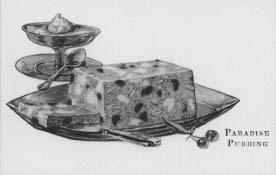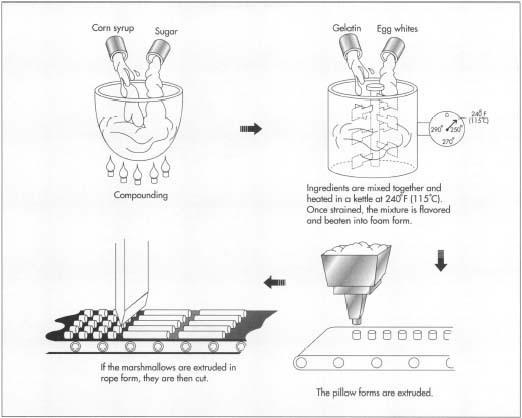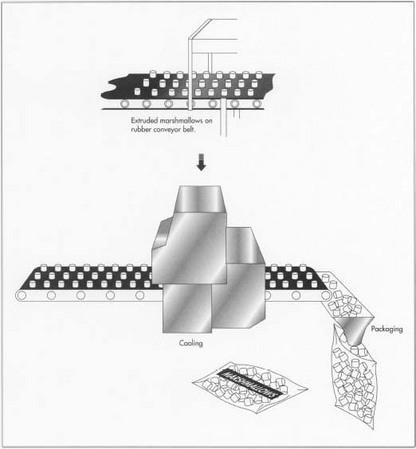Marshmallow
Background
Marshmallows are one of the earliest confections known to humankind. Today's marshmallows come in many forms, from solid (soft pillows dropped in cocoa or roasted on a stick) to semi-liquid (covered in chocolate or formed into chicks for Easter) to the creme-like (used as a base in other candies or as an ice cream topping). In essence, all marshmallows are aerated candies.
History
Originally, however, marshmallows were made from the root sap of the marsh mallow (Althaea officinalis) plant. It is a genus of herb that is native to parts of Europe, north Africa, and Asia. Marsh mallows grow in marshes and other damp areas. The plant has a fleshy stem, leaves, and pale, five-petaled flowers. The first marshmallows were made by boiling pieces of the marsh mallow root pulp with sugar until it thickened. After it had thickened, the mixture was strained and cooled. As far back as 2000 B.C. , Egyptians combined the marsh mallow root with honey. The candy was reserved for gods and royalty.
The marsh mallow root also has medicinal qualities. Marsh mallow roots and leaves can work as a laxative. It also was used by early Arab doctors as a poultice to retard inflammations. Marsh mallow roots were also used in treating chest pains, to soothe coughs and sore throats, and as an ointment. Whether used as a candy or for medicinal purposes, the manufacturing process of marsh mallows was limited to a small, almost individual, scale. Access to marsh mallow confections was limited to the wealthy until the mid-nineteenth century. Common people only tasted marsh mallows when they took pills; doctors sometimes hid the medicine inside the candy to cover the pill's undesirable taste.
Modern marshmallow confections were first made in France around 1850. This first method of manufacture was expensive and slow because it involved the casting and molding of each marshmallow. French candy makers used the mallow root sap as a binding agent for the egg whites, corn syrup, and water. The fluffy mixture was heated and poured onto the corn starch in small molds, forming the marshmallows. At this time, marshmallows were still not mass manufactured. Instead, they were made by confectioners in small stores or candy companies.
By 1900, marshmallows were available for mass consumption, and they were sold in tins as penny candy. Mass production of marshmallows became possible with the invention of the starch mogul system of manufacture in the late nineteenth century. In the starch mogul system, a machine automatically fills trays with starch about 2 in (5.08 cm) thick, which is then evened off and slightly compressed. Then a printing board, made of plaster, wood, or metal trays shaped to mold the marshmallow of the final product is pressed into the starch and withdrawn. Then the space created is filled with hot creme. The first moguls were wood, but all were steel by 1911. Gelatin and other whipping agents replaced the mallow root in the ingredient list.
In 1955, there were nearly 35 manufacturers of marshmallows in the United States. About this time, Alex Doumak, of Doumak, Inc., patented a new manufacturing method called the extrusion process. This invention changed the history of marshmallow production and is still used today. It now only takes 60 minutes to produce a marshmallow. Today, there are only three manufacturers of marshmallows in the United States, Favorite Brands International (Kraft marshmallows), Doumak, Inc., and Kidd & Company.
Raw Materials
Marshmallows are made from only a few ingredients, which fall into two main categories: sweeteners and emulsifying agents. Sweeteners include corn syrup, sugar, and dextrose. Proportionally, there is more corn syrup than sugar because it increases solubility (the ability to dissolve) and retards crystallization. Corn starch, modified food starch, water, gum, gelatin, and/or whipped egg whites are used in various combinations. The resulting combination gives the marshmallows their texture. They act as emulsifying agents by maintaining fat distribution and providing the aeration that makes marshmallows puffy. Gum, obtained from plants, also can act as an emulsifier in marshmallows, but it is also important as a gelling agent.
Most marshmallows also contain natural and/or artificial flavoring. If they are colored marshmallows, the color usually. comes from an artificial coloring.
The Manufacturing
Process
Cooking
- 1 A solution is formed by dissolving sugar and corn syrup in water and boiling it. Egg whites and/or gelatin is mixed with the sugar solution. Then the ingredients are heated in a cook kettle to about 240°F (115°C). The resulting mixture is passed through a strainer to remove extraneous matter.
- 2 In the pump, the mixture is then beaten into a foam to two or three times its original volume. At this stage, flavoring can be added.

In the early twentieth century, marshmallows were considered a child's confection, dispensed as penny candy at general stores along with licorice whips and peppermint drops. But through a fortuitous connection with other popular foods and some clever marketing, marshmallows would soon become a staple ingredient at pot-luck dinners, family get-togethers, and even elegant parties.
A perusal through twentieth-century cookbooks and recipe booklets reveals that marshmallows usually served as an ingredient in cakes, candies, and desserts. They also became well-known as a topping for steaming cups of hot cocoa and as a roasted treat at cookouts and picnics. Increasingly, they served as a sweet addition to salads and side dishes, including their classic contribution to the Thanksgiving dinner table—atop a dish of baked sweet potatoes or yarns.
The 1935 recipe booklet, "Campfire Marshmallow Cookery," expanded upon the usual marshmallow classics with 50 "perfect" recipes. These ranged from everyday dishes like marshmallow ice box loaf and campfire rice pudding to special occasion desserts, including a selection of dainty marlows and mallobets (or ice creams and sherbets).
Perhaps the greatest distinction for marshmallows occurred as a result of their advantageous connection with gelatin salads and desserts, which rose in popularity during the 1920s and 1930s. Recipe booklets for Jell-O and Knox Gelatine from that time include recipes that called for marshmallows on almost every page—recipes like banana fluff, lime mallow sponge, cocoa tutti frutti, and paradise pudding.
Donna R. Braden
Forming
-
3 The heated mixture is transferred to a heat exchanger. Air is pumped into the mixture. The mixture cools in a tempering kettle, passes through another filter, and
continues on to the "hill." Marshmallows are extruded through a machine or deposited onto bands.
The extrusion process involves the foam being squeezed through a die to produce marshmallow's familiar pillow shape. Usually, they get a coating of corn starch to counter stickiness and help maintain their form after they have been extruded. Sometimes the pillows are formed into a rope of pillows. If so, they are cut and dried on a rubber conveyor belt.
Cooling
- 4 After the pillows are formed, they are sent through a cooling drum, where excess starch is removed. They also are cooled enough to be packaged.
Packaging
- 5 After the pillows have cooled, they are weighed and packaged. Before being put in cases, some manufacturers pass their product through a metal detector. The case is code dated and shipped to retail stores.
Quality Control
Throughout the manufacturing process, marshmallows are checked for extraneous matter. The mixture passes through strainers, screens, and metal detectors. Visual inspections are also used to ensure quality. Many marshmallow manufacturers have standards for many aspects of a marshmallow, including its size and texture. An ideal marshmallow should be light. This quality

An ideal marshmallow is created in a manufacturing environment where the size of the bubbles in the foam that forms the marshmallow is controlled. These small bubbles should be evenly distributed throughout a stable foam. If several factors are controlled, including every factor of the beating process, marshmallows will be formed correctly. A substandard marshmallow has large bubbles. These bubbles are conducive to syrupy layers and voids.
Where to Learn More
Periodicals
Groves, Reg. "Process Control of Marshmallows." Candy Industry, July 1991, p.20.
Groves, Reg. "Technology and techniques in marshmallow production." Candy Industry, September 1995, pp. 46-53.
Other
Marshmallow fluff site. 1996. http://www.marshamallowfluff.com (July 9, 1997).
— Annette Petrusso
its quite useful , for future projects